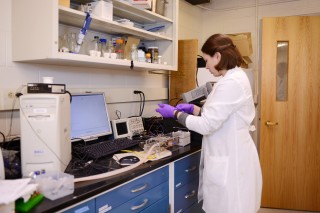Scientists test a Nanoparticle “Alarm Clock” to Awaken Immune Systems Put to Sleep by Cancer

A nanoparticle lab at Dartmouth's Geisel School of Medicine
One pioneering approach, discussed in a review article published this week in WIREs Nanomedicine and Nanobiotechnology, uses nanoparticles to jumpstart the body’s ability to fight tumors. Nanoparticles are too small to imagine. One billion could fit on the head of a pin.
This makes them stealthy enough to penetrate cancer cells with therapeutic agents such as antibodies, drugs, vaccine type viruses, or even metallic particles. Though small, nanoparticles can pack large payloads of a variety of agents that have different effects that activate and strengthen the body’s immune system response against tumors.
There is an expanding array of nanoparticle types being developed and tested for cancer therapy. They are primarily being used to package and deliver the current generation of cancer cell killing drugs and progress is being made in that effort.
“Our lab’s approach differs from most in that we use nanoparticles to stimulate the immune system to attack tumors and there are a variety of potential ways that can be done,” said Steve Fiering, PhD, Norris Cotton Cancer Center researcher and professor of Microbiology and Immunology, and of Genetics at the Geisel School of Medicine at Dartmouth. “Perhaps the most exciting potential of nanoparticles is that although very small, they can combine multiple therapeutic agents.”
The immune therapy methods limit a tumor’s ability to trick the immune system. It helps it to recognize the threat and equip it to effectively attack the tumor with more “soldier” cells. These approaches are still early in development in the laboratory or clinical trials.
“Now that efforts to stimulate anti-tumor immune responses are moving from the lab to the clinic, the potential for nanoparticles to be utilized to improve an immune-based therapy approach is attracting a lot of attention from both scientists and clinicians. And clinical usage does not appear too distant,” said Fiering.
Fiering is testing the use of heat in combination with nanoparticles. An inactive metallic nanoparticle containing iron, silver, or gold is absorbed by a cancer cell. Then the nanoparticle is activated using magnetic energy, infrared light, or radio waves. The interaction creates heat that kills cancer cells.
The heat, when precisely applied, can prompt the immune system to kill cancer cells that have not been heated. The key to this approach is minimizing healthy tissue damage while maximizing cancerous tumor destruction of the sort that improves recognition of the tumor by the immune system.
Fiering cautions that there is a great deal of research and many technical variables that should be explored to find the most effective ways to use nanoparticles to heat tumors and stimulate anti-tumor immunity.
According to Fiering, this approach is far from new, “The use of heat to treat cancer was first recorded by ancient Egyptians. But has reemerged with high tech modern systems as a contributor to the new paradigm of fighting cancer with the patients’ own immune system.”
About Norris Cotton Cancer Center at Dartmouth-Hitchcock
Norris Cotton Cancer Center combines advanced cancer research at Dartmouth and the Geisel School of Medicine with patient-centered cancer care provided at Dartmouth-Hitchcock Medical Center, at Dartmouth-Hitchcock regional locations in Manchester, Nashua, and Keene, NH, and St. Johnsbury, VT, and at 12 partner hospitals throughout New Hampshire and Vermont. It is one of 41 centers nationwide to earn the National Cancer Institute’s “Comprehensive Cancer Center” designation. Learn more about Norris Cotton Cancer Center research, programs, and clinical trials online at www.cancer.dartmouth.edu
Media Contact
All latest news from the category: Life Sciences and Chemistry
Articles and reports from the Life Sciences and chemistry area deal with applied and basic research into modern biology, chemistry and human medicine.
Valuable information can be found on a range of life sciences fields including bacteriology, biochemistry, bionics, bioinformatics, biophysics, biotechnology, genetics, geobotany, human biology, marine biology, microbiology, molecular biology, cellular biology, zoology, bioinorganic chemistry, microchemistry and environmental chemistry.
Newest articles

“Nanostitches” enable lighter and tougher composite materials
In research that may lead to next-generation airplanes and spacecraft, MIT engineers used carbon nanotubes to prevent cracking in multilayered composites. To save on fuel and reduce aircraft emissions, engineers…

Trash to treasure
Researchers turn metal waste into catalyst for hydrogen. Scientists have found a way to transform metal waste into a highly efficient catalyst to make hydrogen from water, a discovery that…

Real-time detection of infectious disease viruses
… by searching for molecular fingerprinting. A research team consisting of Professor Kyoung-Duck Park and Taeyoung Moon and Huitae Joo, PhD candidates, from the Department of Physics at Pohang University…





















